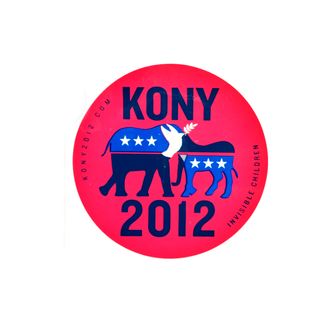
On Monday the advocacy group Invisible Children launched an affecting video, Kony 2012, to raise awareness about child soldiers in Africa and advance the group’s goal of ultimately killing or capturing Ugandan rebel leader Joseph Kony. The response has been staggering: The 30-minute clip has tallied more than 32 million views on YouTube, dominated Facebook news feeds, spawned numerous trending topics on Twitter, and garnering media attention from foreign policy publications to tech blogs. Inevitably it has also spurred a backlash.
But why now? There has been an International Criminal Court warrant out for Kony’s arrest since 2005. Invisible Children has released eleven of these films over the years. The ever-growing importance of social media is obviously a factor, but Invisible Children’s real innovation was to virtually guilt-trip an influential list of A-List celebrities.
First came an effective product: Invisible Children has a multimillion-dollar marketing budget, which helped to pay for a polished, professional video that combines a jarring, visceral subject with high production values and a flashy soundtrack, including Nine Inch Nails and Mumford and Sons.
But the real pipeline to big numbers was the Kony 2012 website, which features “The Culturemakers,” a slick, visual chart of twenty celebrities, including Oprah, Justin Bieber, Jay-Z, Angelina Jolie, Bill Gates, Bono, and more. “When they speak, the world listens,” the website says. And to encourage them to speak, clicking on any of the celebs’ photos automatically crafts a tweet directed at the Culturemaker, complete with the Kony 2012 web address and two related hashtags. The interface is easy, it’s quick — messaging all twenty celebs would take less than two minutes — and most importantly, it allows anyone to feel like they’re making a difference.
Between Tuesday and Wednesday, Oprah, Ryan Seacrest, Kim Kardashian, Rihanna, and Bono’s ONE organization have all written about Kony. They have about 45 million followers combined.
Beneath the celebrities section of the Kony 2012 site is the same setup for policymakers, including George W. Bush, Condoleeza Rice, Mitt Romney, Bill Clinton, and others. While politicians have been slower to respond, they also command less influence on social media, and their follower accounts are dwarfed by Lady Gaga and her ilk.
Reddit was also an early advocate of the video, with a post that shared the video appearing on the influential front page two days ago. The subsequent discussion of the campaign’s validity was fervent, and hundreds of posts debating the topic now exist. The Kony meme, serious as it is, has even combined with nerds’ favorite bits of Internet humor, giving the story even longer legs.
Then there’s the everyday person — your aunt, your high school best friend, your boss — clearly moved by the subject matter, curious about the buzz, or inspired by the conversation. “I, for one, can’t remember the last time so many of my Facebook friends shared the same link,” wrote one Mashable writer. The Kony 2012 Facebook group has around 400,000 likes, and dozens and dozens of copycat groups. It’s awe-inspiring, regardless of one’s opinion of intervention in Africa or non-profits.
After years and years of abuses, the online mobilization of millions doesn’t make solutions for Uganda feel any closer, but if awareness — however fleeting — is a goal for Invisible Children, then they’re inarguably having a hell of a week.





























